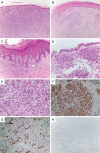Melanoma subtypes: genomic profiles, prognostic molecular markers and therapeutic possibilities
- PMID: 30511391
- PMCID: PMC6492003
- DOI: 10.1002/path.5213
Melanoma subtypes: genomic profiles, prognostic molecular markers and therapeutic possibilities
Abstract
Melanoma is characterised by its ability to metastasise at early stages of tumour development. Current clinico-pathologic staging based on the American Joint Committee on Cancer criteria is used to guide surveillance and management in early-stage disease, but its ability to predict clinical outcome has limitations. Herein we review the genomics of melanoma subtypes including cutaneous, acral, uveal and mucosal, with a focus on the prognostic and predictive significance of key molecular aberrations. © 2018 The Authors. The Journal of Pathology published by John Wiley & Sons Ltd on behalf of Pathological Society of Great Britain and Ireland.
Keywords: 31-gene expression profile; acral; biomarkers; cutaneous; desmoplastic; driver genes; melanoma; mucosal; mutations; predictive; prognostic; uveal.
© 2018 The Authors. The Journal of Pathology published by John Wiley & Sons Ltd on behalf of Pathological Society of Great Britain and Ireland.
Figures


References
Publication types
MeSH terms
Substances
Grants and funding
LinkOut - more resources
Full Text Sources
Medical
Research Materials

